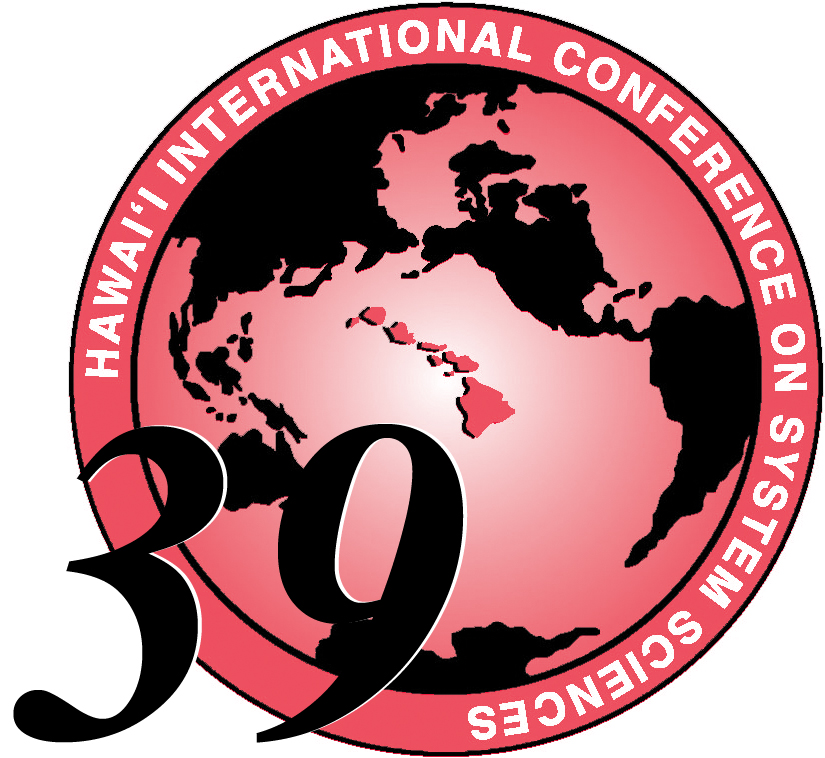
Responsibilities of a HICSS Minitrack Chair

|
|
The HICSS series of conferences has become a unique and respected forum in computer and information systems and technology for the exchange of ideas among the researchers and development communities in North America, the Asian and Pacific Basin nations, Europe, and the Middle East. A Track consists of three full days of parallel technical sessions, coupled with a set of advanced seminars and tutorials. A Minitrack is either a half-day or a full-day of technical sessions. Participants may be involved in several different tracks.
1. Workshop-like Setting
A HICSS Minitrack consists of a set of 90-minute sessions conducted in a workshop-like setting. A full-day Minitrack is 4 sessions; a half-day is 2 sessions. Each session consists of three papers; each paper is summarized by the Author(s) in 15 minutes with another 15 minutes devoted to discussion and questions. In a full-day Minitrack, the last session may consist of an "open forum" which typically is a lively, open dialogue on the issues raised in the presentations. You are to solicit manuscripts, have them refereed, collaborate with the Track Chair in determining which manuscripts are to be accepted, structure the sessions, introduce the speakers in your sessions, and act as the moderator of the forum.
There are no "panels" at HICSS. Panels typically involve people that have little connection to the written record of the conference. Panels are walk-on/walk-off and those involved often do not participate in the full slate of conference activities. If you have a topic that seems suited for a panel discussion, please contact the Track Administrator Eileen Dennis eidennis@indiana.edu for guidelines for developing a Special Forum.
2. Solicit Manuscripts for the Minitrack
After your Track Chair Minitrack approves your Minitrack, you are encouraged to publicize your Minitrack. Please observe the guidelines in the HICSS Publicity Plan. You should solicit high-quality manuscripts from people who are known to do excellent work in the field. We recommend you contact potential Authors and referees to describe the overall objectives of the conference and the Minitrack, and solicit their ideas, a manuscript, or a commitment to referee.
Each submitted manuscript should be 22-25 double-spaced pages in length. Do not accept submissions that are significantly shorter or longer than this. The material must contain original results and not have been submitted elsewhere while it is being evaluated for acceptance to HICSS. Manuscripts that have already appeared in publication are not to be considered for this conference.
3. Acquire Referees Who Will Critically Review all Manuscripts Submitted to You
Quality refereeing is essential to ensure the technical credibility of HICSS. Each manuscript should be stringently reviewed by a number of qualified people who are actively working in the topics dealt with in the paper. You are responsible for having each manuscript reviewed by at least four people in addition to yourself. The Author should only be given those reviews that are technically substantive.
Note: If you wish to submit a paper to your own Minitrack, six copies should be sent to the Track Chair who will administer the refereeing process. Do not use Authors of manuscripts as referees, as this potentially places them in a conflict of interest situation. HICSS does not have "invited" manuscripts; all submissions go through a rigorous peer refereeing process.
4. Accept Manuscripts for the Minitrack
A full-day Minitrack should accept 10-11 papers, and a half-day Minitrack should accept five to allow time for the "open forum" discussions. To ensure excellent accepted papers, typically more than two to three times the number of papers needed must actually be solicited. Many papers will not meet our quality standards (i.e., will not make it through the refereeing process) and some Authors may not be able to fulfill their initial commitment and complete the paper for you. If nine technically solid papers do not survive the refereeing process, the full-day Minitrack can be changed to a half-day session.
5. Republication of the Enhanced Manuscripts
We encourage you to work with an Editor-in-Chief of a professional society periodical to use your accepted papers as the basis of a special issue of the publication. Such an arrangement encourages quality submission and requires good refereeing standards. Enter into such an agreement as soon as possible.
6. Write an Introduction to the Minitrack for the Proceedings
After Authors have been notified of the acceptance of the final version of their manuscript, you are to write an Introduction to the Minitrack (maximum length: one page) for inclusion in the conference proceedings. This should not be an overview of the papers, but should introduce the reader to the important issues that exist in the research area. Due October 1.
7. Select a Best Paper Nomination from the Manuscripts
After you have selected the manuscripts for inclusion in your Minitrack, your candidate Best Paper selection must be forwarded to the Track Administrator. If you have your own manuscript accepted in your Minitrack, you may include your paper in addition to another.
An external committee will make the selection for the Best Paper in the track, considering your manuscript along with the candidates you have provided. Due October 1
8. Follow the HICSS Publicity Plan
So that all the announcements for the many tracks and Minitracks are consistent, and so that redundancy in bulletin boards and other channels is controlled, it is necessary to develop a standard approach to the announcements and calls for papers at HICSS.